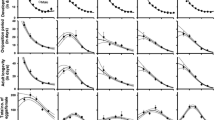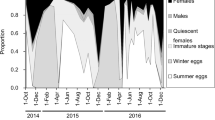Summary
Individuals of the two-spotted spider mite, Tetranychus urticae Koch (Acarina: Tetranychidae), with and without a capacity for diapause, coexist in central Japan. Diapause appears to be adaptive because females in diapause suffered less mortality than non-diapausing individuals when frozen at −24°C for more than 4 h. However non-diapausing females showed good survival up to 4 h of freezing. Active non-diapausing mites survived on rose leaves in Kyoto (35°N) throughout the winters of 1988–1989 and 1989–1990. Cultures of mites with low (LD) and high (HD) diapause capacities at 18°C and 9L-15D photoperiod were successfully selected from the rose population and from a population on chrysanthemum in Nara (34.4°N). Their life-history traits at 15, 20, 25 and 30°C were characterized. HD and LD mites from both populations were of similar ages at first reproduction at 15–30° C. However, at temperatures ≥20° C, HD individuals produced more eggs than LD individuals, resulting in higher fecundity and intrinsic rate of natural increase. These traits allow HD individuals, which stop breeding between October and April, to increase faster in summer than LD individuals. This provides a mechanism, together with climatic fluctuations, in maintaining the coexistence of diapausing and non-diapausing T. urticae in Kyoto where winter conditions are rarely lethal to the non-diapausing individuals.
Similar content being viewed by others
References
Ando Y (1983) Diapause and geographic variation in a leaf beetle. In: Brown VK, Hodek I (eds) Diapause and life cycle strategies in insects. Dr Junk Publ., The Hague pp 127–141
Brandenburg RL, Kennedy GG (1981) Overwintering of the pathogen Entomophtora floridana and its host, the twospotted spider mite. J Econ Entomol 74:428–431
Cone WW, Wright LC, Wildman TE (1986) Reproduction by overwintered Tetranychus urticae (Acari: Tetranychidae) on hops. Ann Entomol Soc Am 79:837–840
Ehara S (1956) Some spider mites from Northern Japan. Jour Fac Sci Hokkaido Univ Ser VI Zool 12:244–258
Gotoh T (1986) Annual life cycle of the two-spotted spider mite, Tetranychus urticae Koch (Acarina: Tetranychidae), on Ribes rubrum L. in Sapporo: the presence of non-diapausing individuals. Appl Ent Zool 21:454–460
Gotoh T, Shinkaji N (1981) Critical photoperiod and geographical variation of diapause induction in the two-spotted spider mite, Tetranychus urticae Koch (Acarina: Tetranychidae), in Japan. Jap J Appl Ent Zool 25:113–118 (In Japanese with English summary)
Hayes JL (1982) Diapause and diapause dynamics of Colias alexandra (Lepidoptera: Pieridae). Oecologia 53:317–322
Helle W (1968) Genetic variability of photoperiodic response in an arrhenotokous mite (Tetranychus urticae). Ent Exp Appl 11:101–113
Japan Meteorological Agency (1971–1990). Annual report. Tokyo, Japan
SAS Institute (1985) SAS user's guide: statistics, version 5 edition. North Carolina
Stenseth C (1965) Cold hardiness in the two-spotted spider mite (Tetranychus urticae Koch). Ent Exp Appl 8:33–38
Takafuji A, Kamibayashi M (1984) Life cycle of a non-diapausing population of the two-spotted spider mite, Tetranychus urticae Koch in a pear orchard. Res Popul Ecol 26:113–123
Takafuji A, Inoue M, Oda M (1989) Diapause attribute of Tetranychus urticae populations from Nara Prefecture, Japan. Jpn J Appl Ent Zool 33:134–139 (In Japanese with English summary)
Tauber MJ, Tauber CA, Masaki S (1986) Seasonal adaptations of insects. Oxford Univ. Press, New York
Veerman A (1985) Diapause. In: Helle W, Sabelis MW (eds) Spider mites. Their biology, natural enemies and control. Vol 1A. Elsevier, Amsterdam, pp 279–316
Wipking W (1988) Repeated larval diapause and diapause-free development in geographic strains of the burnet moth Zygaena trifolii Esp. (Insecta, Lepidoptera) I. Discontinuous clinal variation in photoperiodically controlled diapause induction. Oecologia 77:557–564
Author information
Authors and Affiliations
Rights and permissions
About this article
Cite this article
So, PM., Takafuji, A. Coexistence of Tetranychus urticae (Acarina: Tetranychidae) with different capacities for diapause: comparative life-history traits. Oecologia 87, 146–151 (1991). https://doi.org/10.1007/BF00323792
Received:
Accepted:
Issue Date:
DOI: https://doi.org/10.1007/BF00323792




